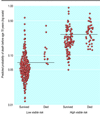"Unwarranted survivals" and "anomalous deaths" from coronary heart disease: prospective survey of general population - PubMed (original) (raw)
"Unwarranted survivals" and "anomalous deaths" from coronary heart disease: prospective survey of general population
A McConnachie et al. BMJ. 2001 Dec.
Abstract
Objectives: To assess survival in people who are at apparent high risk who do not develop coronary heart disease ("unwarranted survivals") and mortality in people at low risk who die from the disease ("anomalous deaths") and the extent to which these outcomes are explained by other, less visible, risk factors.
Design: Prospective general population survey.
Setting: Renfrew and Paisley, Scotland.
Participants: 6068 men aged 45-64 years at screening in 1972-6, allocated to "visible" risk groups on the basis of body mass index and smoking.
Main outcome measures: Survival and death from coronary heart disease by age 70 years.
Results: Visible risk was a good predictor of mortality: 13% (45) of men at low risk and 45% (86) of men at high risk had died by age 70 years. Of these deaths, 12 (4%) and 44 (23%), respectively, were from coronary heart disease. In the group at low visible risk other less visible risk factors accounted for increased risk in 83% (10/12) of men who died from coronary heart disease and 29% (84/292) of men who survived. In the high risk group 81/107 who survived (76%) and 19/44 (43%) who died from coronary heart disease had lower risk after other factors were considered. Different risk factors modified risk (beyond smoking and body mass index) in the two groups. Among men at low visible risk, poor respiratory function, diabetes, previous coronary heart disease, and socioeconomic deprivation modified risk. Among men at high visible risk, height and cholesterol concentration modified risk.
Conclusions: Differences in survival between these extreme risk groups are dramatic. Health promotion messages would be more credible if they discussed anomalies and the limits of prediction of coronary disease at an individual level.
Figures
Figure
Athlete Florence Griffith-Joyner (1959-98) died of an apparent heart attack just 10 years after winning her first Olympic gold medal
Figure
Predicted probabilities of death before age 70 years, based on adjusted model derived from data on men at intermediate visible risk, for men at low and high visible risk who survived to age 70 years or died from coronary heart disease before age 70 years. Horizontal lines represent predicted probabilities for men at intermediate risk, adjusted for categories of smoking and body mass index
Figure
Defying all the odds for surviving into old age
Similar articles
- Risk factors for cardiorespiratory and all cause mortality in men and women in urban Scotland: 15 year follow up.
Watt GC, Hart CL, Hole DJ, Smith GD, Gillis CR, Hawthorne VM. Watt GC, et al. Scott Med J. 1995 Aug;40(4):108-12. doi: 10.1177/003693309504000403. Scott Med J. 1995. PMID: 8787109 - Sudden coronary death in women.
Kannel WB, Wilson PW, D'Agostino RB, Cobb J. Kannel WB, et al. Am Heart J. 1998 Aug;136(2):205-12. doi: 10.1053/hj.1998.v136.90226. Am Heart J. 1998. PMID: 9704680 - Should diabetes be considered a coronary heart disease risk equivalent?: results from 25 years of follow-up in the Renfrew and Paisley survey.
Whiteley L, Padmanabhan S, Hole D, Isles C. Whiteley L, et al. Diabetes Care. 2005 Jul;28(7):1588-93. doi: 10.2337/diacare.28.7.1588. Diabetes Care. 2005. PMID: 15983305 - Relation between coronary risk and coronary mortality in women of the Renfrew and Paisley survey: comparison with men.
Isles CG, Hole DJ, Hawthorne VM, Lever AF. Isles CG, et al. Lancet. 1992 Mar 21;339(8795):702-6. doi: 10.1016/0140-6736(92)90599-x. Lancet. 1992. PMID: 1347584 - Exercise-based rehabilitation for coronary heart disease.
Jolliffe JA, Rees K, Taylor RS, Thompson D, Oldridge N, Ebrahim S. Jolliffe JA, et al. Cochrane Database Syst Rev. 2000;(4):CD001800. doi: 10.1002/14651858.CD001800. Cochrane Database Syst Rev. 2000. PMID: 11034729 Updated. Review.
Cited by
- Patient and practitioner views on cancer risk discussions in primary care: a qualitative study.
Blane DN, MacDonald S, O'Donnell CA. Blane DN, et al. BJGP Open. 2022 Mar 22;6(1):BJGPO.2021.0108. doi: 10.3399/BJGPO.2021.0108. Print 2022 Mar. BJGP Open. 2022. PMID: 34645652 Free PMC article. - Response to written feedback of clinical data within a longitudinal study: a qualitative study exploring the ethical implications.
Lorimer K, Gray CM, Hunt K, Wyke S, Anderson A, Benzeval M. Lorimer K, et al. BMC Med Res Methodol. 2011 Jan 27;11:10. doi: 10.1186/1471-2288-11-10. BMC Med Res Methodol. 2011. PMID: 21272336 Free PMC article. - How should public health professionals engage with lay epidemiology?
Allmark P, Tod A. Allmark P, et al. J Med Ethics. 2006 Aug;32(8):460-3. doi: 10.1136/jme.2005.014035. J Med Ethics. 2006. PMID: 16877625 Free PMC article. Review. - 'Coming down the line'-- patients' understanding of their family history of common chronic disease.
Walter FM, Emery J. Walter FM, et al. Ann Fam Med. 2005 Sep-Oct;3(5):405-14. doi: 10.1370/afm.368. Ann Fam Med. 2005. PMID: 16189056 Free PMC article. - William Pickles lecture. General practice and the epidemiology of health and disease in families.
Watt G. Watt G. Br J Gen Pract. 2004 Dec;54(509):939-44. Br J Gen Pract. 2004. PMID: 15588541 Free PMC article. No abstract available.
References
- Charlton J, Murphy M, Khaw K, Ebrahim S, Davey-Smith G. Cardiovascular diseases. In: Charlton J, Murphy M, editors. The health of adult Britain 1841-1994. London: Stationery Office; 1997. pp. 60–81.
- Department of Health. National service framework for coronary heart disease. London: Department of Health; 2000.
- Department of Health. Saving lives: our healthier nation. London: HMSO; 1999.
Publication types
MeSH terms
LinkOut - more resources
Full Text Sources


